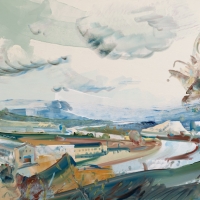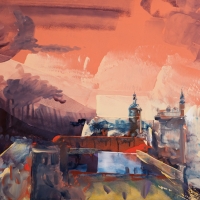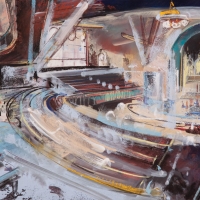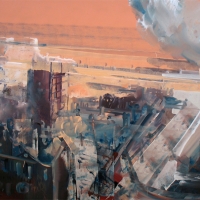James Carey of Loudon 1751-1834
The Pastoral Surroundings of a Country Seat and Baltimore Town
Commission for the Johns Hopkins Carey Business School Series
The W.P. Carey Foundation commissioned a suite of large oil paintings based on historic Baltimore during the life and times of James Carey (1751-1834) of Loudon, the great early Baltimore businessman for whom Johns Hopkins Carey Business School is named.
Suite of Paintings and Drawings

Paintings installed in the Legg Mason Tower, Johns Hopkins Carey Business School
A Confluence of Business and Art (Artist Statement)
This collaboration emerged while Bill Carey and I were viewing an exhibition of the British figurative painter Lucian Freud at the Museum of Modern Art in New York City. We were both moved by the rich backstory Freud’s remarkable portraits evoked. We strongly related to the notion that a common virtue necessary in today’s business and art worlds is human empathy. To illustrate this invisible truth we chose the life and extraordinary times of Mr. Carey’s ancestor James Carey, a public-spirited and creative businessman, as the subject of a suite of paintings and drawings. Our conversations continued, and in October 2008 we reviewed preliminary sketches in his Rockefeller Plaza office and a contract for the commissioned suite of eight oil paintings and six drawings was approved and signed on January 2009. During this interim, I traveled to and did extensive research at key sites in Maryland connected with the Carey family, including the Homewood House, Loudon Cemetery, Thomas Viaduct, B&O Railroad Museum, Sharp Street Memorial United Methodist Church, and the Maryland Historical Society.
The notion of making “historic paintings” is drawn from an academic genre which is dependent upon a literal translation of particular places and events. My paintings of James Carey’s Baltimore are not historic paintings in this sense, but reenactments executed with a contemporary sensibility. This project has been an opportunity not only to help keep history alive, but keep painting relevant as a means to engage the living past. In envisioning the social and economic realities of the eighteenth and nineteenth centuries, I’ve engaged modern oil painting techniques, particularly the use of foam rollers. This produces a quality of mark and porous texture that expresses the synthetic, fast-paced nature of our own era while awakening our senses to Baltimore’s pre-industrial dawn.
I am deeply grateful to Bill Carey who inspired and generously supported this creative enterprise. We have, through this suite of paintings and drawings, presented James Carey’s life as a powerful civic inspiration for Baltimore, and created an enduring testament to what can be accomplished when business and art come together.
– David Brewster, 2010





















